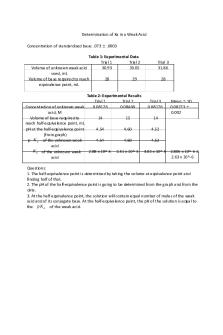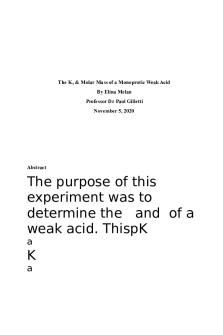Determination of Ka of Unknown Weak Acid PDF

| Title | Determination of Ka of Unknown Weak Acid |
|---|---|
| Author | Nica Belliard |
| Course | Biological Chemistry |
| Institution | Florida International University |
| Pages | 10 |
| File Size | 194.8 KB |
| File Type | |
| Total Downloads | 82 |
| Total Views | 144 |
Summary
Chemistry complete lab report...
Description
Determination of Ka of Unknown Weak Acid February 4th, 2016 Nicole Belliard Martuscelli TA: Kenny Lang CHM 114 R2
Belliard 2
Purpose: The purpose of this experiment is to calculate the acid dissociation constant (Ka) of an unknown weak acid (Belliard Martuscelli, Nicole) by titrating it with a strong base of known concentration, and hence determining the initial concentration of the weak acid. The calculations will be determined using two methods: Measuring the pH of the weak acid solution of known concentration and finding the half equivalence point where pH1/2 = pKa. The Ka is an important value to know since it is a great indicator of acid strength and conductivity.
Introduction: The Ka of an acid serves as an indicator of acid strength. It is a value that is closely related to pH, the higher the value, the stronger the acid. In this lab, the investigation involves the titration of a weak acid with a strong base using a pipet, a buret, a stirrer and a pH meter. The steady increase in pH is recorded as small increments of base are added to the solution. The equivalence point is noted by carefully monitoring the pH change. Weak acids dissociate partially in water and create a buffer solution when combined with a strong base. For this experiment, the model equation: HA + H2O –> H3O+ + ASets up the equation:
Belliard 2 This equation will be used after the calculation of the initial diluted HA concentration, using c=n/v, where n is the number of moles and v is the volume. As the strong base is added, the acid concentration decreases and its salt (conjugate base) concentration increases, forming a
Belliard 3 basic solution. In a buffer solution the acid and its salt are both present and the dissociation of the weak acid is negligible, therefore, [HA]initial=[HA]equilibrium. At half equivalence point, the concentration [HA]initial=[A-]equilibrium, making it easy
to calculate Ka using the equation:
. Since the ratio between the
concentrations is one, log(1)=0 and, therefore, pH = pKa and Ka = 10-pka.
Procedures: 1. Pour 10 mL of distilled water into a 50 mL beaker after rinsing it with distilled water. 2. Rinse the pipet with the unknown solution. 3. Pipet 10 mL of the unknown solution into a 50 mL beaker. 4. Carefully add the 10 mL of weak acid into the beaker that contains the water to dilute the acid. 5. Use the pH meter to calculate the initial pH of the diluted weak acid. 6. Rinse the buret with the NaOH solution and fill it with approximately 50 mL of the same solution, make sure there are no bubbles at the tip of the buret. 7. Record the initial volume and concentration of the NaOH solution. 8. Place the beaker containing the diluted weak acid under the buret, place the magnetic stirrer under the beaker. 9. Open the stopcock to allow about 0.5 mL of NaOH into the beaker. 10. Record the volume of NaOH added and the pH of the solution in the beaker. 11. Repeat steps 9 and 10 until you reach a pH of about 4.75.
Belliard 3 12. Start adding only two drops of NaOH at a time. Each time record the volume of NaOH used and the pH of the solution in the beaker
Belliard 4
13. After equilibrium is stablished, go back to adding 0.5 increments of NaOH to the beaker until a pH of about 12 is reached. Always recording the amount of base added and the new pH. 14. Clean all the instruments with distilled water and put them in their respective places. Data and Observations:
Initial volume of NaOH: 1.59 mL
Initial volume of Belliard Martuscelli, Nicole (weak acid): 20.00 mL
Initial pH of weak acid: 2.27
Table: Weak Acid vs. Strong Base Volume of
pH of
Volume of
pH of
Volume of
pH of
0.0982 M
solution in
0.0982 M
solution in
0.0982 M
solution in
NaOH
the beaker
NaOH
the beaker
NaOH added the beaker
added (mL) 0.00 0.60 1.22 1.79 2.52 3.13 3.81 4.30 5.01 5.60 6.20 6.84 7.90 8.52
2.27 2.39 2.51 2.60 2.72 2.81 2.90 2.96 3.05 3.12 3.19 3.26 3.37 3.44
added (mL) 9.14 9.93 10.50 11.06 11.76 12.38 13.11 13.91 14.54 14.64 14.75 14.84 14.92 15.02
3.51 3.61 3.68 3.76 3.87 3.98 4.15 4.42 4.84 4.97 5.13 5.40 5.91 8.38
(mL) 15.12 15.36 15.43 15.69
9.69 10.35 10.50 10.66
15.81 16.02 16.21 16.41 16.96 17.50
10.82 10.95 11.03 11.11 11.26 11.37
Belliard 5
The pH steadily grows from 2.27 until about 5.40. Then it grows faster until pH of about 10.35 and slows down again until it reaches 11.37. The buffer solution contains the acid and its salt. Since the salt equals the amount of OH- added at half equivalence point the acid and salt concentrations are equal when 7.51 mL of NaOH is added. The equivalence point occurs when pH > 7 since the conjugate base becomes more prevalent as equilibrium shifts to the right. After the equivalence, the pH levels off due to an excess of NaOH. Interpolation of the equivalence points provides an estimation of the pH, approximately 3.31 at half equivalence point and 8.38 at equivalence point. Calculations: Method 1: Moles of NaOH used to reach equilibrium = (0.0982 mol/L)(0.01502 L) = 1.47 x 10-3 mol
Belliard 6
HA + H2O –> H3O+ + A- (1:1 ratio) Molarity of [HA]original = (1.47496 x 10-3 mol) / 0.01 L = 1.47 x 10-2 M (mol/L) Therefore, [HA]diluted = (1.147 x 10-2 M) / 2 = 7.35 x 10-3 M Ka = (1.47496 x 10-3)2 / (7.35 x 10-3) = 2.96 x 10-4 pKa = -log(Ka) = 3.53
Method 2: Half equivalence point = 15.02 mL / 2 = 7.51 mL Using interpolation, the pH at 7.51 mL = 3.31 pKa = 3.31 Ka = 10-3.31 = 4.57 x 10-4 Conclusion and Discussion: The titration lab successfully portrayed the close to ideal relationship that exists between the weak acid and strong base solutions. The experiment resulted in a measurement of the Ka using two different methods. The accuracy of the two values cannot be measured due to the fact that the theoretical Ka value of the unknown acid was not provided. However, the two values are different, presenting that one method produces a closer result to the actual value. Systematic errors are represented by the deviations of the titration curves compared to the true values. Offset errors have been collected though the mishandling of instruments. The measurements therefore are less accurate. There were many measurements made even before the titrations that could have gone wrong. The repeated transfer of solution from beaker to beaker may have has an effect on the proper reading of the resulting 20 mL of diluted acid. Another
Belliard 7 major systematic error roots from the reading of the buret. Since the buret is a small tube, it was extremely difficult to precisely measure the NaOH volume added, and decreased precision results in less reliable pH readings and equivalence point. Despite the presence of an array of exceptional error as presented by the methods, the two calculated values of Ka are not too conflicting. They both present relatively weak acids. The value calculated by using the second method is less accurate because the value of the pH was interpolated from the graph. The Ka derived fro the equation is more accurate because it takes into consideration al the variables including the concentration of the original acid and the diluted acid. Hence, this is the reason why the first Ka value presents a more reliable value. Improvements can be made to improve the monitoring of the pH as specific increments of the base are added. The precise readings of the buret and the other equipments such as the beaker would have definitely resulted in accurate equivalence points. The stirrer ad the constant position of the pH meter helped the procedure of finding the pH after each increment was added. Finally, more detailed qualitative data should have been taken to monitor the accompanying pH changes by adding an indicator.
Belliard 7...
Similar Free PDFs
Popular Institutions
- Tinajero National High School - Annex
- Politeknik Caltex Riau
- Yokohama City University
- SGT University
- University of Al-Qadisiyah
- Divine Word College of Vigan
- Techniek College Rotterdam
- Universidade de Santiago
- Universiti Teknologi MARA Cawangan Johor Kampus Pasir Gudang
- Poltekkes Kemenkes Yogyakarta
- Baguio City National High School
- Colegio san marcos
- preparatoria uno
- Centro de Bachillerato Tecnológico Industrial y de Servicios No. 107
- Dalian Maritime University
- Quang Trung Secondary School
- Colegio Tecnológico en Informática
- Corporación Regional de Educación Superior
- Grupo CEDVA
- Dar Al Uloom University
- Centro de Estudios Preuniversitarios de la Universidad Nacional de Ingeniería
- 上智大学
- Aakash International School, Nuna Majara
- San Felipe Neri Catholic School
- Kang Chiao International School - New Taipei City
- Misamis Occidental National High School
- Institución Educativa Escuela Normal Juan Ladrilleros
- Kolehiyo ng Pantukan
- Batanes State College
- Instituto Continental
- Sekolah Menengah Kejuruan Kesehatan Kaltara (Tarakan)
- Colegio de La Inmaculada Concepcion - Cebu















